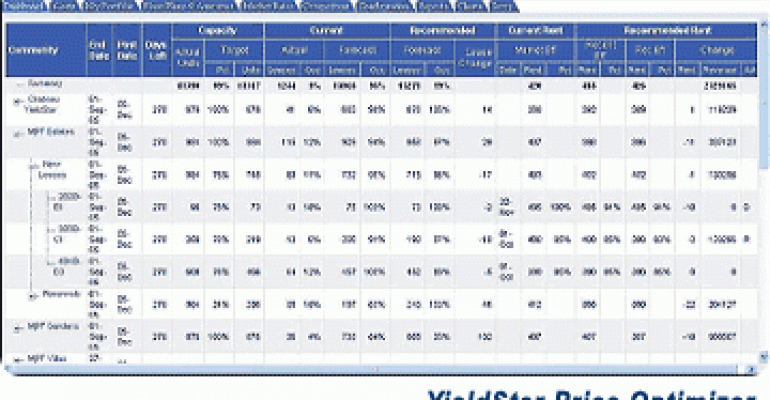In the fast-moving multi-family housing market, where local conditions seem to change every day, wouldn’t it be great to have a real-time pricing system, just like the airlines, which know exactly the probability of filling a given seat at a given price on a given day? In the past three years, two rental management programs — Lease Rent Optimizer and YieldStar Price Optimizer — have appeared, claiming to do just that.
The Web-based applications chew up data on supply, demand, competitor prices, unit characteristics and other variables and then spit out rents daily. Software company Manugistics Group Inc. developed Lease Rent Optimizer for Archstone-Smith, which bought the intellectual property rights and now sells the product to other apartment owners. YieldStar was developed by Jeffrey Roper, president of apartment research firm M/PF YieldStar in Carrollton, Texas.
The technology generally costs about $2 to $4 a unit per month — it generally gets cheaper as the number of units grows — but it’s proving its worth in squeezing more profits out of multifamily assets, say users and promoters of the software. Executives with Houston-based Camden Property Trust, a $7 billion REIT that rolled out YieldStar across its nearly 200-property portfolio last December, recently told analysts that the software added 1% to 2% to its first quarter net operating income (NOI). That 1% increase over a year would add $6 million to annual NOI, according to Keith Oden, Camden’s president and COO.

Revenue management software has a key advantage for landlords: It introduces objectivity into pricing by removing the human element. No matter how familiar the owner or manager is with his property and markets, no human can accurately weigh the dozens of variables that the software typically crunches. Nor do these systems get tripped up by emotions — they aren’t afraid that a rival will do something irrational.
Atlanta-based Post Properties, a REIT that owns some 60 communities, primarily in the Southeast, tested Lease Rent Optimizer in seven markets early this year. To get the software churning, apartment owners typically punch in around 150 pieces of information: a two-year history of demand, traffic and leasing data for a particular unit type as well as details about expiring leases.
When Post recently turned the software on for the first time at its 389-unit Post Hyde Park community in Tampa, the system suggested boosting rents by $200 a month, or 18%. That was on top of 10% to 15% increases that property managers already had put in place this year, says Thomas Wilkes, president of Post Apartment Management. That seems like a lot all at once, but it reflected the new realities of the local market, where rising interest rates are sending would-be condo buyers back to rental markets.
“We leased two apartments for $200 more a unit than we would have rented them for the day before,” says Wilkes. “So a property manager who thinks he’s had success because he obtained a 10% rent increase might, in fact, have been able to get a 25% increase.”

